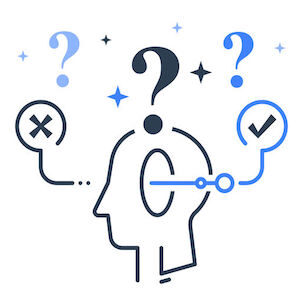By Dr. Ken Broda Bahm:

This blog is dedicated to the proposition that those like me, who want to learn all they can about effective communication and persuasion, can take lessons from almost everything. Even the worst social situations can improve our understanding of the ways that people process information and reach decisions. The current social and economic disruptions brought about by the coronavirus pandemic, however, have not just been a lesson, they’ve been a masterclass. In the last few months, I feel that we have learned a lot about human nature, some of it reassuring, and some of it decidedly less so.
In particular, our response to the COVID-19 crisis can be seen as a laboratory of cognitive biases. A recent article in Scientific America, “Overcoming Psychological Biases Is the Best Treatment Against COVID-19 Yet,” interviews several psychologists and others who study biases in thinking, in sharing examples of several ways that our social and political responses to the pandemic have been hampered and distorted by our mental habits. Scott Halpern of the University of Pennsylvania notes, “The fact that certain politicians do habitually repudiate science does make the situation worse. But the point is that, even absent that, these biases hold tremendous sway.” Moving toward better policies, or even toward better personal choices, requires understanding these biases. Students of persuasion, including persuasion in the now-elusive jury context, requires understanding them as well. In this post, I will share four biases discussed in the article, touching also on what they mean in a litigation context.
Hopefulness
As the summer moves to a close, many of us are still working from home, traveling little or not at all, or otherwise living radically altered lives. If you rewind back to early spring, we had hoped, even expected, that things would be a little closer to normal by now. This “optimism bias” is the self-protective belief that things tend to get better over time and will work out in the end. It is sometimes at odds with the facts.
Jurors can also be influenced by a bias toward hopefulness. If they see a tragically injured person, they will usually err on the side of hope. In other words, if there is a chance that a person will improve, they will award damages as though the chance was reality. Large awards can be motivated as much by optimism (the expectation that things can get better and resources can help) as they can be motivated by punishment.
Innumeracy
For health professionals, dealing with a pandemic is a matter of numbers and relative risk. The public, however, is not always able to grasp the numbers. In the Scientific American article, the writer uses the example of the public’s inability to grasp exponential growth. By default, we expected the virus to grow linearly — if there were 30 local cases in a week, then in two weeks you would expect 60 cases, not 600 cases. As the article explains, “The enormity of the resulting difference between linear and exponential growth is evident when you imagine that taking 30 linear steps from your front door gets you across the street while 30 exponential steps takes you around the globe 26 times.”
Jurors can have some of the same issues when it comes to numbers. As I’ve written before, numeracy can be a trait that’s worth assessing in your potential jurors, and will have a substantial affect on jurors’ interpretations of risk and on the reasonability that jurors use to anchor their damages.
Motivated Reasoning
The article also mentions motivated reasoning, or “our tendency to decide what evidence to accept based on the conclusion we prefer.” Those who don’t want to wear masks will find reasons that masks don’t work or are counterproductive, and those criticizing the government’s response will be similarly motivated to doubt even the good actions that have been taken.
The adage that “motivations lead and reasons follow” applies to jurors as well. If they want to find for the plaintiff, then they will view the evidence through that filter, but if they feel that a defense verdict has more social value, they’ll interpret the same facts in a different light. For that reason, it makes sense to consider motivations and not just reasons.
Follow the Leader
Finally, the article focuses on the role of leadership. Joris Lammers of the University of Cologne in Germany notes, “If the leader of your party says a certain thing is exaggerated, and it matches this bias, many people are strongly inclined to believe that.” It is a shortcut: instead of analyzing an issue on our own, we simply adapt the views of whatever leaders we respect and follow.
Jurors will do the same. Watch a mock jury deliberate and you will see that most of the movement within that jury can be traced back to the roles of one person or a few people. That is why it is essential to consider not just a juror’s individual attributes, but also their potential to be a leader within that jury, and to give those potential jurors extra attention during jury selection.
This is just a sample of kinds of biases that are playing out in the current crisis. We can also see “Just World” beliefs (when bad things happen, people probably did something to cause that), and personal exceptionalism (we see ourselves as exceptions to the rule). In all cases of deeply set biases, the realistic response is usually not to try to cure them, but to instead account for them in your messages.
____
______
Other Posts on Cognitive Biases:
- Know Your Cognitive Biases
- Know Your Cognitive Biases, Part 2
- Account for Proportionality Bias: Big Events Must Have Big Causes
- Consider the Contagiousness of Bias
______
Image credit: 123rf.com, used under license